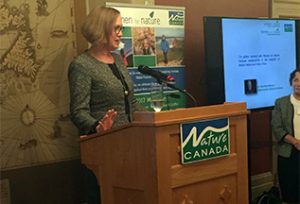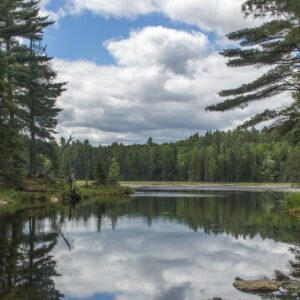Interview of Dr. Brenda Kenny, Co-chair of Women for Nature

Featuring Women for Nature member Dr. Brenda Kenny, Co-chair of Women for Nature. Written by fellow Women for Nature member Sharolyn Mathieu Vitesse.
Sharolyn (S): When reading about your outstanding accomplishments, and then when listening to you talk, you come across as someone who is down-to-earth, open, and inclusive, but I was intrigued when you mentioned that when working cooperatively, all boats rise with the tide. How did you reach that conclusion?
Brenda (B): The opposite of that saying is the tall poppies syndrome where people are hesitant to speak out because they will be cut to size. In my experience, you get better end-results when listening to all interested parties. There are some people who are really feisty with social activism – I’m not against that – but it doesn’t solve the problem. We need a good way to work together, and challenge assumptions to get to what everybody wants to accomplish.

“Nature’s future, our future, requires us to collaborate, innovate, and lead. We are working together to sustain biodiversity and heart-felt connection to nature across our great country.” Dr. Brenda Kenny, pictured above, and Professor Ann Dale, Co-Chairs of Women for Nature.
S: Can you give an example?
B: There is a group called the Clean Air Strategic Alliance (CASA) in Alberta. It is consensus based and when it started, there were those who wanted zero emissions, and on the other hand were the emitting facilities saying that they would if they could, but the technology didn’t exist to do that. What was actually achieved was a 65% reduction in 10 years by understanding all affected parties’ positions. It depends on how you look at the numbers. Look at costs and opportunities in different ways, and see ways to get there, including good regulation.
What happened was that the government used the CASA targets to set clean air standards. This mandated companies to adopt the new technology to meet the new standard which resulted in energy reductions, reduced emissions, and operating savings. These are all positive impacts. Some companies took it further, and are looking at opportunities to save money and reduce environmental impacts with waste recovery projects, and to sell the generated energy to the grid. It goes to show how important it is to have open dialogues because how we get to the solutions is often not a straight line.
S: Has there been a cultural shift towards climate change?
B: Yes, there has been a tipping point. Companies are signing on, and there are many, many willing partners. Companies like Suncor and NAL Resources Management, which is owned by Manulife, are adopting new technologies to improve their extraction and business practices. It is a very exciting time. We can do things smarter as we transition away from high emissions to low emissions. Less coal and fossil fuel and more renewable energy like wind and solar, is a big shift. Also, improvements are a huge opportunity to reduce greenhouse gas emissions in new and unexpected ways. I think Canada is well-positioned and can have a huge role to help other countries be cleaner, and more efficient as well.
S: You broke through the glass ceiling when you became the past president of the Canadian Energy Pipeline Association (CEPA) for eight years. What was that like?
B: I didn’t feel like I was breaking down barriers at the time. I found it was crucial to have a woman’s voice at a senior level at a time when there were crucial discussions about environment and pipelines. In that capacity, I travelled the country and met a lot of people to advance the national interest, safety, and environment. It was a great time to be involved because the industry wanted to do more. My leadership style is cooperative, so I enjoyed it at that time, as difficult as it was. My approach was to focus on the outcome, and not on the dogma.

S: As a pathfinder in a male dominated field, what advice would you have for women who want to follow in your footsteps?
B: My advice to young women is to never follow the career path that others set for you. Only pursue what you want to do, and apply that because it will be a good fit for you. Know yourself. Don’t drift into something, but be where you want to put your heart, mind, and time. If you want to live in a way that you can make a difference about what you care about, then you had better know what you are trying to do. You may not meet your goal, but if it is a worthy cause, then it is time well spent.
To be successful, you have to have the tools to be successful, but don’t fall into the women’s trap. What that is, is when a job is posted, a man will apply and say, “I can learn”, whereas a woman will say, “I will learn first, and then I can apply”. You need to be capable and ready for the challenge, but knowing that things are not going to be perfect.
S: Pipelines and oil companies are not known to care about loss of habitat, or their effects on the environment, and yet you care passionately about nature. How were you able to connect the two?
B: I’ve asked this question many times. I can’t back away from this. 2/3 of energy use is fossil based. We are transitioning, and doing it quickly but we still need energy here, and energy needs are growing abroad. It is about having the best possible protection for the environment while providing the product and services people need. I’d rather be inside the circle, and having an impact to do that. I care deeply about environment as do many in industry. I know that standing outside of industry doesn’t have the same impact. Having said that, it is important to actively bridge different viewpoints. I try to look for the variances that will move things forwards. Sometimes it is like being a conductor. All I know is that we get smarter, better, and faster when working as a team. For example, about 7-8 years ago, the pipeline industry started working cooperatively with each other regarding safety in the industry. It was super powerful, but it happened by changing the whole conversation.
S: How do you view Women for Nature?
B: We are like Team Canada! We have a diverse group of women from across Canada with a common interest, which is Nature. We have the network, and the passion. If we want Canada to be great, we shouldn’t throw away what makes us Canadian.



